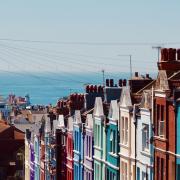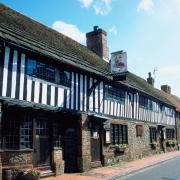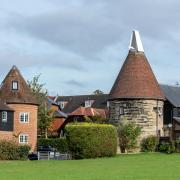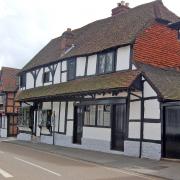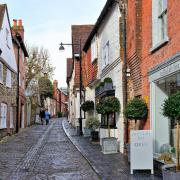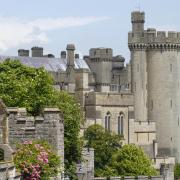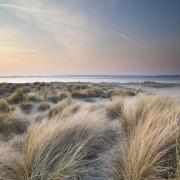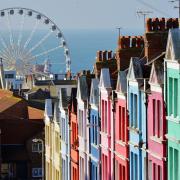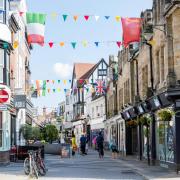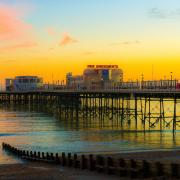How has our perception of the British seaside been moulded by the preferences of our forebears? Historian Kathryn Ferry investigates

The seaside towns we know and love are the result of centuries of changing holiday fashions. The things we expect to find there – the buildings, promenades and even the food culture – are derived from the preferences of our forebears.
Many of the attractions and treats they favoured have become staples of our own seaside experiences. Some hang on as mere remnants, others survive with almost iconic status.
Sandcastles, donkeys, piers and sticks of rock. Beach huts, grand hotels, comic postcards and ice cream cones. All of these things have their own history which, added together, makes the seaside the distinctive place it is today. In my new book I focus on 100 objects which tell our national seaside story from the 18th to the 21st century.
Seaside culture originated in the Georgian trend for medicinal sea bathing. Whatever ailed you, there was a doctor willing to prescribe a health-giving trip to his own stretch of shore.
A medic from Lewes, Dr Richard Russell, became the best-known advocate after he published A Dissertation on the Use of Sea-Water in the Diseases of the Glands, particularly, The Scurvy, Jaundice, King’s Evil, Leprosy and the Glandular Consumption in 1750.
Russell sent his patients to nearby Brighton and their aristocratic status set the town on its rise to fame and fortune.
In Sussex we’re lucky enough to have a wide range of seaside resorts with some very influential buildings. Thanks to royal patronage what happened in Georgian Brighton became a model for resort development around the country.

The most obvious example of this is the wonderfully exotic Royal Pavilion, which later inspired a fashion for oriental domes in architecture around the coast, particularly on piers. Brighton’s own Palace Pier had an Edwardian theatre topped with numerous onion domes.
However, the first time that domes were used to ornament a pier structure was at Hastings in 1872. The engineer in that case was Eugenius Birch, the man who was responsible for Brighton’s West Pier and at least 13 other piers around the British coast.
Between the wars, it was another Sussex town, Bexhill, that led the way in resort architecture. The De La Warr Pavilion is an outstanding example of International Modernism that was copied from the Isle of Wight to the Isle of Bute.
With its sleek white lines and streamlined curves the De La Warr Pavilion represented a new era in beach fashions, when sunbathing became ‘the thing’ and women first learnt the emancipatory power of wearing trousers in the form of wide beach pyjamas, a style pioneered by Coco Chanel on the French Riviera.
At outdoor swimming pools like Saltdean Lido, opened in 1938, British holidaymakers threw off the clothing and formality of their Victorian parents and grandparents to revel in a freer seaside experience.
Then came World War II. Sussex beaches suddenly became the frontline in our fight against Nazi Germany: tourists were banned, piers were cut short so they couldn’t be used by invading forces and coils of barbed wire were laid across beaches.
If getting back to the coast felt good after the recent COVID-19 lockdown, imagine how incredible it felt in 1945 after five years of hostilities finally came to an end.

The 1950s and 60s saw demand for British seaside holidays peak. Butlin’s Bognor opened in 1960, with the holiday camp soon welcoming 2,000 weekly campers. During that period the home-made knitted swimsuit gave way to the skimpy bikini as we became a richer and more liberal society.
And, as sunnier foreign destinations became increasingly accessible through package deals, people started looking further afield for their annual holidays. Our old-fashioned resorts looked just that and it took until the 1990s for signs of a renaissance to appear.
The humble beach hut led the way as renewed demand caused prices to hit the tens of thousands; at places like West Wittering would-be hutters could expect to be on the waiting list for up to ten years. An important shift had taken place with people who could easily afford to holiday abroad now actively choosing to spend their leisure time in simple little structures on the British coast.
Thankfully, many of the key things we associate with the seaside managed to come through the difficult years and those that now belong to the past still have the power to provoke happy holiday memories.

You may well have your own anecdote about the carpet gardens at Eastbourne, the Butlin’s Red Coats at Bognor, a ride on Volks Electric Railway or your first pair of flip-flops. At its best the Great British Seaside is unashamedly nostalgic.
Embracing its long-standing traditions is crucial to moving forward because if you took them away all you would be left with is a series of towns that happen to be by the sea.
We need to celebrate the sugar-laden sticks of rock and the tacky Kiss Me Quick hats as part of our shared heritage, adding our own layers to the seaside story just as our ancestors have done.
I believe that knowing a bit more about those previous layers actually helps us enjoy a day trip to the beach even more. So, if the pandemic means you’re planning to spend more time at the British seaside this year, here are a few things to think about on your next visit.

The infamous puppet Mr Punch has been around since 17th century when diarist Samuel Pepys was among the first to see him perform in Restoration London. Over time, Punch lost his strings and gained a long-suffering wife called Judy.
The couple were a common sight at fairgrounds until the spread of the railways in Victorian times meant it was easier for their puppet masters to get to the seaside and the captive holiday market. Nowadays Prof Glyn Edwards and his family stage performances on Brighton seafront and visit schools in the area, bringing the heritage into the 21st century.
Trains were absolutely crucial to the growth of seaside resorts. The stage coach journey from London to Brighton took six hours; with the arrival of the railway in 1841 this was reduced to just two. Another form of steam transport that is now all but redundant was the paddle steamer.
As well as taking people to their seaside destinations it also offered the chance for day excursions. The firm of PA Campbell ran its south coast fleet from the 1890s to 1956, allowing passengers to hop on and off at Brighton, Eastbourne, Hastings, Newhaven and Worthing.

The modern division between land and sea is a man-made one, usually consisting of the sea wall needed to keep the waves at bay and the promenade which beautifies it and offers a place to walk and socialise.
All around the coast, promenades are dotted with little shelters designed to provide a seat out of the wind from whichever direction it blows.
These shelters probably developed from the wind screens that were a noted innovation on Brighton’s West Pier when it opened in 1866.
So when you’re tucking into fish and chips on the beach this summer, or laying waste to an ice cream, consider how these things became part of the quintessential coastal experience – and how modern tastes might shape the seaside of the future.
If you want to know when fish and chips were first put together or what people did before the invention of the ice cream cone, Kathryn Ferry’s book Seaside 100: A History of the British Seaside in 100 Objects is out now, published by Unicorn, priced £14.99.




